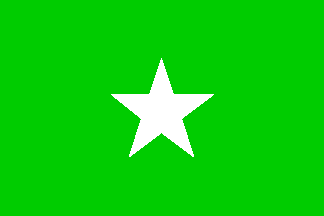 image by Ivan Sache, 12 April 2009
image by Ivan Sache, 12 April 2009
Last modified: 2024-03-02 by rob raeside
Keywords: education |
Links: FOTW homepage |
search |
disclaimer and copyright |
write us |
mirrors
See also:
Other Institutions:
 image by Ivan Sache, 12 April 2009
image by Ivan Sache, 12 April 2009
"Instituciòn Educativa Normal Superior 'Fabio Lozano
Torrijos' " is based at Falan, Department of Tolima. Founded
in 1942 as "Escuela Vocacional Agrícola de Falan", the
institute became a "Normal Superior" in 1965 (Law No.
283).
The institute is named after the diplomat Fabio Lozano Torrijos,
who prepared with Alberto Salomón the treaty known as the
Salomón-Lozano Treaty. Signed at Lima (Peru) on 24 March 1928,
the treaty solved the border controversy between Colombia and
Peru. Fore more details see Wikipedia.
The flag of the institute, as shown graphically on the
institute's website, is green with a white star in the middle.
Ivan Sache, 12 April 2009
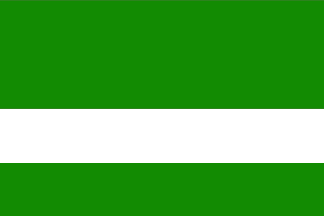 image by Ivan Sache, 12 December 2020
image by Ivan Sache, 12 December 2020
The flag of Institución Educativa Municipal Instituto Técnico Industrial de
Facatativá (Cundinamarca) is horizontally divided (2:1:1) green-white-green.
http://itifistas.edu.co/itif/index.php/colegio/imagen-institucional/
School website
Ivan Sache, 12 December 2020
 image by Ivan Sache, 22 September 2014
image by Ivan Sache, 22 September 2014
Liceo Campestre Facatativá was established in 2003 in Facatativá (Cundinamarca
Department). The institute incorporated in 2003 Colegio Personitas, which had
succeeded in 1986 Guardería Jardín Personitas, itself established on 5 September
1983.
Source:
http://www.liceocampestrefacatativa.edu.co - Institute's website
The flag of the institute was adopted in 1998 in a student's competition. The
flag is made of a white lozenge charged with the institute's emblem and
four triangles in the four corners: coffee brown (upper left corner), green (upper
right corner), blue (lower left corner), and orange (lower right corner). Coffee
brown is a symbol of the fertility of the soil and of the local customs and
context. Blue is a symbol of joy, enthusiasm, and spirituality. Green is a
symbol of hope, peace, prosperity, and natural environment. Orange is a symbol
of friendship and loyalty.
The emblem of the institute features a sun symbolizing all the aspects of the
student's life. The lower part of the sun is yellow, representing the
expectations, the aspirations, and the need of knowledge of the community. The
upper part of the sun is white, symbolizing an autonomous, responsible, critic,
analytical, tolerant, and competent student with a spirit of investigation and a
strong feeling of belonging.
Source:
http://www.liceocampestrefacatativa.edu.co/include/simbolos.php -
institute's website
Ivan Sache, 22 September 2014
It looks a bit
Tananasia-n.
According to IMDB, Thunder in
Paradise is from 1994. That's about the right time frame to indeed be an
influence for this flag.
Peter Hans van den Muijzenberg, 14 April 2015
 image by Ivan Sache, 11 September 2022
image by Ivan Sache, 11 September 2022
I.E. Faltriquera, located in the municipality of Piedecuesta (department of
Santander), is composed of nine rural schools, Faltriquera, El Granadillo, La
Palma, Las Rosas, Menzulí Alto, Menzulí Chiquito, La Aurora, El Cubín and El
Limonal.
The flag of I.E. Faltriquera is horizontally divided
blue-white-green with the school's coat of arms in the center.
Blue
represents the region's water resources.
White represents the community's
nobleness, loyalty, love, and spiritual and moral value.
Green represents the
natural environment par excellence, the mountains and the region's resources, as
well as safety, harmony and the student's personal and social growth.
The
coat of arms of I.E. Faltriquera has a circular shape, representing unity. The
motto "Dios, Familia y Sociedad" (God, Family and Society) means commitment to
integral education of students. The two blackberry branches represent the
region's natural resources and products. The rainbow and the two mountains
united by its light represent imparting knowledge, ethics, values and the
interests of children and teenagers who love their fatherland without forgetting
their origins. The book is a symbol of knowledge as a tool for the region's
growth and transformation. The blue rim represents the region's water resources.
https://faltriqueraescuelaruralsanluis.home.blog/simbolos-institucionales -
School website
Ivan Sache, 11 September 2022
 image by Ivan Sache, 28 July 2011
image by Ivan Sache, 28 July 2011
Flag without emblem, as used
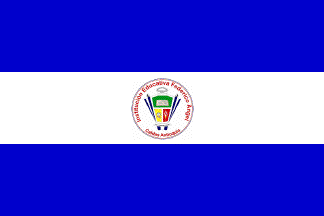 image by Ivan Sache, 28 July 2011
image by Ivan Sache, 28 July 2011
Flag with emblem, as prescribed for official use - but, seemingly, not used
Escuela Urbana de Varones Federico Ángel, located in Caldas (Department of
Antioquia) was founded on 20 September 1967 by Departmental Decree No. 536. On
29 January 2003 (Decree No. 595), the institute was merged with Colegio José
María Bernal and renamed Institución Educativa José María Bernal Sección
Federico Ángel. On 24 February 2005 (Decree No. 1954), the section became
Institución Educativa Federico Ángel. The institute is named for Federico Ángel,
a noted educationalist from Caldas.
The flag of the institute is presented as follows on the institute's website:
"The flag is made of three horizontal stripes of equal size. The upper and lower
stripes are blue. Blue symbolizes the commitment in the quest of knowledge, the
care for a better future, the serenity required to solve conflicts and liberty
of speaking, thinking and acting. The central stripe is white. White symbolizes
transparency required from all the members of the educational community, as well
as the youth educated in the institute, therefore its central location on the
flag.
The flag to be used in public places, celebrations and civic ceremonies shall
have the emblem of the institute placed in the middle."
The photo placed below the description shows the flag without the emblem.
Source:
http://iefangel.org/simbolos/>
The slideshow presenting the institute, dated 20 October 2010, shows a graphic
depiction of the flag with the emblem. However, it includes photos showing
different official stands or parades with the flag consistently without the
emblem. Accordingly, the prescribed flag including the institute's emblem does
not seem to be used frequently, provided it actually exists.
Source:
http://iefangel.org/2010/10/20/7838/
The emblem of the institute is presented as follows on the institute's website:
"The shield of the institute is trapezoid, divided into three quarters with the
colours of the municipal flag of Caldas. The upper quarter shows on a green
field an open book. The lower left quarter shows on a yellow field a hand
holding the globe. The lower right quarter shows on a red field a hand holding
an Olympic flame. The upper part of the emblem is inscribed with the institute's
name [in red letters].
The lower part of the emblem [indeed a white scroll placed below the shield] is
inscribed with the motto "SER - CONOCER - HACER" (To be - To know - To do) [The
lower part of the emblem is inscribed with "Caldas Antioquia" in red letters.]
The trapezoid is flanked on each side by the flag of the institute, the two
flags being crossed per saltire below the shield.
The colours of Caldas used in the shield emphasizes the institute's sense of
belonging to the municipality. The open book represents knowledge, wisdom and
investigating spirit as the standard of the academic work. The hand holding the
globe represents personal growth, tenacity and perseverance, the harmony between
Man and Earth, and the respect of nature as a source of life.The hand holding a
torch represents sportive spirit, recreation and joy, as constituting parts of
the institute. The motto summarizes the institute's mission and vision."
Source:
http://iefangel.org/simbolos/
Ivan Sache, 28 July 2011
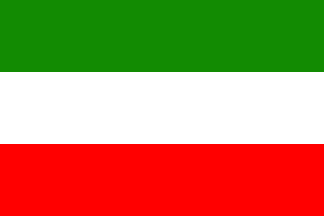 image by Ivan Sache, 11 October 2018
image by Ivan Sache, 11 October 2018
Liceo Federico Froebel was established on 1 February 1977 in Ibagué (Tolima
Department) by Camilo Tibaquirá Ortiz (1925-2005). The school is named for the
German pedagogue Friedrich Fröbel (1782-1852), founder of modern education and
of the concept of Kindergarten.
The flag of Liceo Federico Froebel is
horizontally divided green-white-red.
Green represents aspiration to
achievement.
White represents the children's chastity and innocence.
Red
represents love for life, for the school and for the homeland.
http://liceofedericofroebe8.wixsite.com/liceofedericofroebel/about
School website
Ivan Sache, 11 October 2018
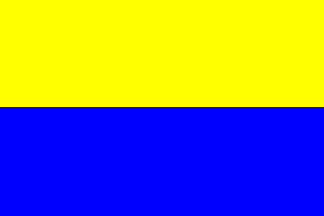 image by Ivan Sache, 14 August 2002
image by Ivan Sache, 14 August 2002
The College was founded in 1946 as Escuela (School) Federico
Ozanam. I have not been able to find out where it is located,
however. Frédéric Ozanam (Milano, 1813 - Marseilles, 1853) was
a French historian and writer. In 1833, he founded the St.
Vincent-de-Paul Society. He rejoined the French Republic in 1848
and founded with Lacordaire the Christian-Democrat newspaper
L'Ere Nouvelle (The New Era, 1848-1849).
The flag of the College is described but not shown as
horizontally divided yellow-blue (amarillo-azul). Therefore I
have used default 2:3 proportion in my image.
Source: <www.educame.gov.co>.
Ivan Sache, 14 August 2002
"Instituto Nacional de Educación Media Diversificada
'Felipe Pérez'" (INEM) was founded in February 1972 in
Pereira, Department of Risaralda.
The institute is named after the politican, lawmaker, writer and
journalist Felipe Pérez (1830-1891), successively appointed
Governor of Zipaquirá and Cundinamarca, Senator of the Republic,
President of the Congress, General, Chief of Staff of the Army
etc...
The flag of INEM,
according to a photo and the description available on the website
of the institute, is white with the emblem of INEM in the
middle. The flag was designed by the Department of Physical
Education in 1975 for the first Interinstitute Games.
The emblem of INEM is a white triangle outlined in
black-yellow-green, charged with the red letters "INEM"
surmonted with a yellow device. "FELIPE PEREZ" is
written in white letters on a blue scroll placed under the
emblem, under which a second, yellow scroll bears
"PEREIRA" in black letters. The whole is inscribed in a
red ring with white writing, probably the full name of the
institute.
Ivan Sache, 14 January 2009
 image by Ivan Sache, 07 July 2011
image by Ivan Sache, 07 July 2011
"Institución Felipe Salame" is located in Rovira (Tolima Department). The
flag of the institute, as shown graphically and described on the institute's
website, is horizontally divided red-white-green. The original flag of the
institute was green and white; in 2005, the teacher Edel Miguel Rubio, finding
the original design too boring, proposed to add a red stripe. Red represents
valor and strength; white represents peace, tranquillity and harmony; green
represents the fields, mountains and landscapes.
Source:
http://felipesalame.es.tl/Simbolos-de-la-Institucion.htm
Ivan Sache, 07 July 2011
 image by Ivan Sache, 06 October 2014
image by Ivan Sache, 06 October 2014
Colegio Ferrini was established in 1965 in Robledo, part of the town of
Medellín (Antioquia Department), by the priest Jesús Emilio Jaramillo Monsalve,
member of the community of the Missionaries of Yarumal. The community
transferred in 1977 the school to Iván Giraldo Zuluaga, who founded in 1978
Instituto San Fernando for the education of girls. Merged in 1991 to form
Instituto San Fernando-Ferrini, the two schools were taken over in 1997 by the
Serfin Educativo S. A. company, which founded the next year Corporación
Educativa Ferrini (Corferrini).
The school is named for Blessed Contardo Ferrini (1859-1902), a Franciscan
scholar, Professor of History of Law and Roman Penal Law at the University of
Pavia. Buried in the chapel of the Catholic University of Milan, Ferrini is
considered as the model of Catholic scholar.
The flag of the institute is horizontally divided into twelve stripes, in turn
blue and white. The blue stripes represent justice, while the white stripes
represent integrity.
Source:
http://www.colegioferrini.edu.co/index.php/institucional/simbolos -
Institute's website
Ivan Sache, 06 October 2014
Having my mother (R.I.P.) graduated from Ferrini, I have two questions:
1) The flag you sent in this message is the High School's flag or the higher
education Institution flag? (and when I refer to higher education Institution, I
refer to after high school)
2) I've always have this institution (Ferrini) as a Technical and Technological
school (Technical Schools' courses are 3 years and Technological Schools'
courses take 4 years).
Now, looking for information on these questions, I came across
this
link titled ¿Instituto o Colegio? (Institution or School, Institution
standing for after High School Education).
Now, in the text in the link provided above, they mention that "in 1997 Iván
Giraldo Zuluaga cedes the Instituto San Fernando Ferrini to the sociedad Serfin
Educativo S. A. (a private company). Then in 1998 the Corporación Educativa
Ferrini – Corferrini is established. In 2009 the owners and managers of
Instituto Ferrini decided to split the formal education program (Robledo
neighborhood location) from the higher education facilities (that operate in
Calasanz and Centro neighborhoods). That is: in
Antioquia there are
three educational centers under the name Ferrini:
1) Colegio Ferrini (Ferrini High School) for kids
2) Instituto Ferrini (Ferrini Institution) for adults who want to validate
their high school degree and they also teach after high school programs
3) Corporación Educativa Ferrini - Corferrini for the creation of
educational programs (policies), working together with both the
Secretaría
de Educación de Medellín (which is the
official government entity in charge of public education in the city) and
with the Secretaría de Educación de Antioquia (which is the official government entity in charge of public education
in the Department, of which Medellín is its capital).
Furthermore, there are actually two official websites:
- Instituto Ferrini (official
website)
- Colegio Ferrini (official
website)
Source:
http://www.colegioferrini.edu.co/index.php/iinstituto-o-colegio
Esteban Rivera, 08 November 2014
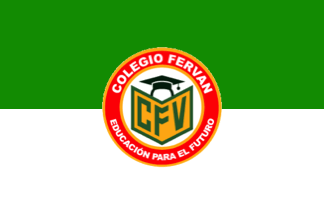 image by Ivan Sache, 1 January 2021
image by Ivan Sache, 1 January 2021
Colegio FERVAN was founded in 1982 in Bogotá, as Instituto de Educación
Preescolar La Abeja Maya. In 1992, the Secretary of Education of Bogotá
recognized (Decree No. 1280) the new name of Colegio FERVAN, designed after the
name of the founder, Lety Fernández Vanegas.
https://colegiofervan.edu.co
School website
The flag of Colegio
FERVAN is horizontally divided white-green with the school's emblem in the
center.
The two equal horizontal stripes are a symbol of balance. White is a
symbol of perfection, purity and peace. Dark green represents life, respect for
the natural environment, hope and tranquility.
The emblem is inscribed in a
ring, symbol of perfection, of red color, symbol of force and vitality, charged
with the name and motto of the college ("Education for the future") in golden
letters, symbol of wealth. The center of the emblem features an open book,
symbol of culture and knowledge, charged with the green letters "C" (for "Collegio"),
"F" (for Fernández) and "V" (for Vanegas). Above the book is the head of a
reader, the active subject of the learning process, wearing a mortarboard, as
the symbol of acknowledgement of academic achievement.
https://colegiofervan.edu.co/el-colegio/#simbolos
School website
Photo
https://www.goethe.de/resources/files/jpg893/fervan-03-formatkey-jpg-w1440r.jpg
Ivan Sache, 1 January 2021
 image by Ivan Sache, 1 January 2021
image by Ivan Sache, 1 January 2021
Colegio FERVAN Campestre is located in Facatativá (Cundinamarca).
Its
symbols are similar to those of Colegio FERVAN, with "CAMPESTRE" added on the
emblem's ring.
The description and explanation of the symbols are exactly the
same for the two schools.
https://colegiofervancampestre.edu.co/el-colegio
School website
Ivan Sache, 1 January 2021
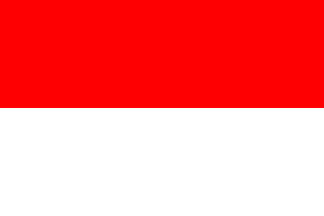 image by Ivan Sache, 30 July 2014
image by Ivan Sache, 30 July 2014
Liceo Fesan was established in April 1993 in Suba (Bogotá).
Fesan (Fondo de Empleados Santanderistas - Santander Employees' Fund) was
created in February 1985 by José Ramón Torres Ladino, director of Instituto
Pedagógico Santander. Out of the 28 employees of the time, 15 joined the
project, of which 5 are still part of the today's project . The initial aim of
the fund was to provide income to the teachers for the months of January and
February. Very successful, Fesan was officially registered in 1991. Fesan
purchased in 1992 a plot in Suba, where a school was built in 1993; the project
was presented on 3-5 July 1993 in the aula of Instituto Pedagógico Santander.
Classes started on 1 February 1994, attended by more than 200 students: Liceo
Fesan, managed since 2003 by Coopfesan (Cooperativa Multiactiva de Fesan),
teaches now 1,400 students.
The flag of the institute is horizontally divided red-white.
Source:
http://www.liceofesan.edu.co/nosotros.html - Institute's website
Ivan Sache, 30 July 2014